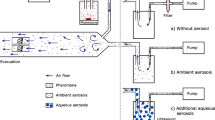Abstract
The mating rate ofEphestia cautella (Walker) was inversely related to the level of pheromone permeating the air. However, permeation did not prevent mating by altering the number of females calling or the frequency, duration, or pattern of male flight. Instead, permeation probably prevented mating by reducing the distance from which a male can respond to a female. The pheromone level necessary to achieve a particular reduction in mating increases with moth density.
Similar content being viewed by others
References
Bartell, R.J., andLawrence, L.A. 1976. Reduction in sexual responsiveness of male light-brown apple moth following previous brief pheromonal exposure is concentration dependent.J. Aust. Entomol. Soc. 15:236.
Brady, U.E. 1973. Isolation, identification and stimulatory activity of a second component of the sex pheromone system (complex) of the female almond moth,Cadra cautella (Walker).Life Sci. 13:227–235.
Brady, U.E., Tumlinson, J.H., Brownlee, R.G., andSilverstein, R.M. 1971. Sex stimulant and attractant in the Indian meal moth and in the almond moth.Science 171:802–804.
Cardé, R.T. 1981. Disruption of long-distance pheromone communication in the Oriental fruit moth: Camouflaging the natural aerial trails from females, pp. 385–398,in Everett R. Mitchell (ed.). Management of Insect Pests with Semiochemicals: Concept and Practices. Plenum Press, New York.
Hagstrum, D.W., andDavis, L.R., Jr. 1980. Mate-seeking behavior ofEphestia cautella.Environ. Entomol 9:589–592.
Huber, R.T., Moore, L., andHoffman, M.P. 1979. Feasibility study of area-wide pheromone trapping of male pink bollworm moths in a cotton insect pest management program.J. Econ. Entomol. 72:222–227.
Kennedy, J.S., Ludlow, A.R., andSanders, C.J. 1980. Guidance system used in moth sex attraction.Nature 288:475–477.
Kuwahara, Y., Kitamura, C., Takahashi, S., Hara, H., Ishii, S., andFukami, H. 1971. Sex pheromone of the almond moth and the Indian meal moth.Science 171:801–802.
LaChance, L.E. 1974. Status of the sterile-insect release method in the world, pp. 55–62,in The Sterile-Insect Technique and Its Field Applications. International Atomic Energy Agency, Vienna.
Mankin, R.W., Vick, K.W., Mayer, M.S., Coffelt, J.A., andCallahan, P.S. 1980. Models for dispersal of vapors in open and confined spaces: Application to sex pheromone trapping in a warehouse.J. Chem. Ecol. 6:929–950.
Mitchell, E.R. 1975. Disruption of pheromonal communication among coexistent pest insects with multichemical formulations.BioScience 25:493–499.
Read, J.S., andHaines, C.P. 1979. Secondary pheromone components and synergism in stored-product Phycitinae.J. Chem. Ecol. 5:251–257.
Richerson, J.V. 1977. Pheromone-mediated behavior of the gypsy moth.J. Chem. Ecol. 3:291–308.
Sanders, C.J. andLucuik, G.S. 1972. Factors affecting calling by female eastern spruce budworm,Choristoneura fumiferana (Lepidoptera, Tortricidae).Can. Entomol. 104:1751–1762.
Shorey, H.H., Gaston, L.K., andSaario, C.A. 1967. Sex pheromones of noctuid moths. XIV. Feasibility of behavioral control by disrupting pheromone communication in cabbage looper.J. Econ. Entomol. 60:1541–1545.
Sower, L.L., andWhitmer, G.P. 1977. Population growth and mating success of Indian meal moths and almond moths in the presence of synthetic sex pheromone.Environ. Entomol. 6:17–20.
Sower, L.L., Turner, W.K., andFish, J.C. 1975. Population-density-dependent mating frequency amongPlodia interpunctella (Lepidoptera: Phycitidae) in the presence of synthetic sex pheromone with behavioral observations.J. Chem. Ecol. 1:335–342.
Author information
Authors and Affiliations
Additional information
Mention of a commercial or proprietary product in this paper does not constitute an endorsement of that product by the USDA.
Department of Entomology and Nematology, University of Florida, employed through a cooperative agreement with the Insect Attractants, Behavior, and Basic Biology Research Laboratory, Gainesville, Florida, 32604.
Rights and permissions
About this article
Cite this article
Hagstrum, D.W., Davis, L.R. Mate-seeking behavior and reduced mating byEphestia cautella (Walker) in a sex pheromone-permeated atmosphere. J Chem Ecol 8, 507–515 (1982). https://doi.org/10.1007/BF00987798
Received:
Revised:
Issue Date:
DOI: https://doi.org/10.1007/BF00987798




